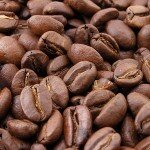Coffee
April 16, 2007 – 6:53 pm
 Coffee
Coffee
 Coffee is a beverage made from roasted beans of the coffee plant; the roasted beans are usually referred to as beans. Coffee is served both hot and cold though hot coffee is consumed in much more quantity than cold coffee. Coffee is consumed as “black†by some while some people add milk, cream and sugar to their coffee. Coffee is one of the most popular beverage in the world. The word coffee is derived from the Arabic term “qahwaâ€.
A legend says that Khalid, an Abyssinian goat herder noticed that his goats became more energetic after eating a particular type of berries. Khalid himself tried the berries and found that they gave energy to him. Upon learning about the berries Khalid’s wife urged him to tell the local monk about the berries. The chief monk declared the berries as “Work of the Devil†and flung the berries into a fire. Upon doing so, the whole room was soon filled with the aroma of roasting berries. The roasted berries were retrieved from fire and dipped in water. After drinking the brew they came to realize that Khalid was telling them the truth. After this the monk used the brew to keep themselves awake during the evening prayers.
Coffee’s history can be traced back to 9th century when it was present in Ethiopia and present Algeria, Morocco and Tunisia. From there it spread to Egypt and Yemen, by fifteenth century coffee had reached Persia, Turkey and northern Africa. From the Middle East coffee went to Europe and became popular there around 17th century. Large scale import was first done by the Dutch. As the Arabs were not allowed to export the coffee plants or unroasted seeds, the Dutch smuggled some seedlings in 1690. They used the seedlings to make coffee plantations at Java, which was a Dutch colony at that time.



Coffee was not as successful in the American colonies as it had been in Europe when it reached there. They didn’t like it as a substitute for alcohol. But today coffee is consumed in consumed in large quantities everyday in the United States and the North American breakfast is incomplete without it.Â
There are two species of the coffee plant, “Coffea arabica†and “Coffea canephora (robusta)â€. Coffea arabica is more susceptible to disease and is considered to be better tasting than the other species. Coffea canephora (robusta) can be grown in regions where arabica can’t be cultivated, it contains 40-50% more caffeine than arabica. It is used as a cheap substitute for arabica in many blends. Robusta is bitterer than arabica and has burnt rubber like flavor. Robusta of good quality is used in some espresso blends to give better foam and to reduce the cost. Many Italian espresso blends use dark-roasted robusta. To remove the undesirable flavors from robusta beans a steam treatment process is used. “Coffea liberia†and “Coffea esliaca†are species of coffee indigenous to Liberia and Sudan respectively.
Arabica coffees were named after the port from which they were exported, like Mocha from Yemen and Java from Indonesia. Currently coffee is labeled according to the country and region producing it. Most of the arabica coffee beans come from Latin America, East Africa/Arabia or Asia Pacific region. The major characteristics of coffee beans are flavor (e.g. earthy and citrus like), aroma, body and acidity. Acidity of a coffee should not be confused with its pH level, it points to the tanginess present in washed or wet-processed coffees. The Ph level of coffee is around 5. The characteristics of coffee depend upon the region where it is grown as well as the how it is processed. “Cracoli†bean is highly prized as it is a coffee bean that develops singly inside the cherry instead of usual pair and hence the flavor is concentrated in it.
Before coffee beans are processed into roasted coffee which is the familiar form of coffee for most of us a lot of processing of the beans has to be done. The coffee berries have to be picked, defruited, dried, sorted and aged. The roasting process has a lot of influence on the taste of coffee. All coffee is roasted before consumption; it can be roasted at home or can be roasted and sold by the supplier. Before being roasted, coffee beans are bland having all the nutrients like protein, acids and caffeine but not the taste of the final product.
Roasted coffee beans have to be grinded before using them to make beverages. Normally coffee is ground at the roastery and sold in packaged form to consumers though the trend of grounding coffee at home is catching up fast.
While the finer grinds such as the “Turkish†grind are mixed straight with water, the “drip†grinds (used in home coffee machines) are prepared by passing water at boiling temperature in a slow stream through the ground coffee in a filter. In espresso, very hot water at less than boiling temperature is forced through the ground coffee which results in a strong flavor. Coffee can be served in a number of ways like with sugar, milk, cream as well as hot and cold. Â
Coffee is usually taken by most people with their breakfast. Coffee is also taken along with dessert after the main course. Coffee is also consumed along with pastries, muffins, doughnuts and cookies.Â
Due to presence of caffeine, a mild stimulant, drinking coffee causes an increase in heart rate, increased blood flow to muscles, increased blood pressure and increased level of dopamine in most of the drinkers. Coffee is consumed in morning to wake up and to ward off sleep due to its stimulating properties.